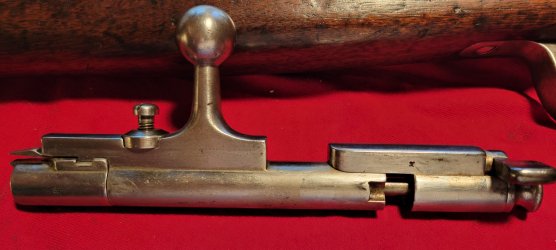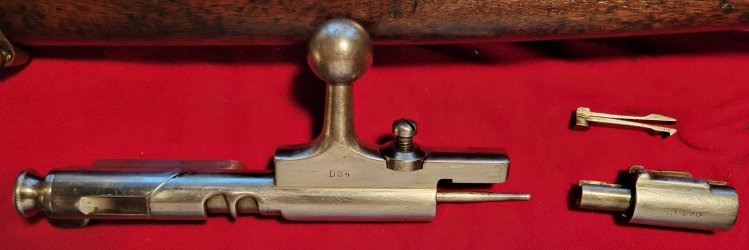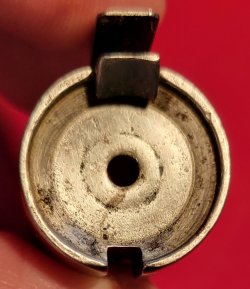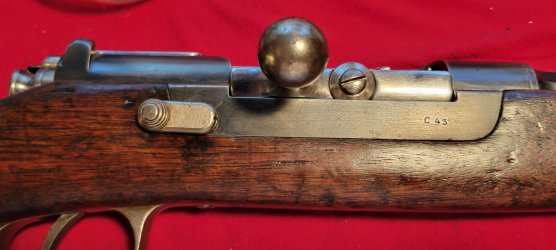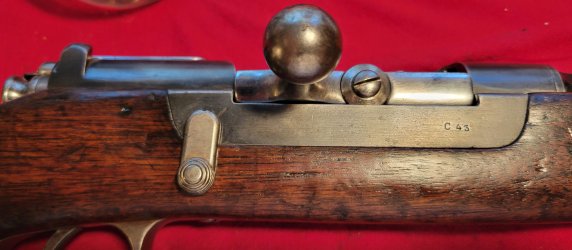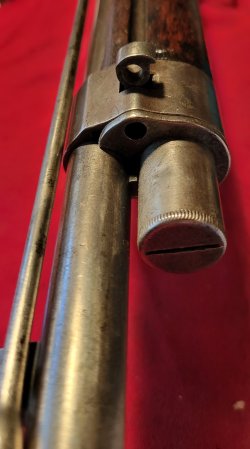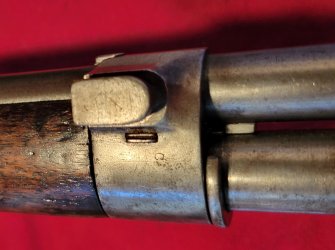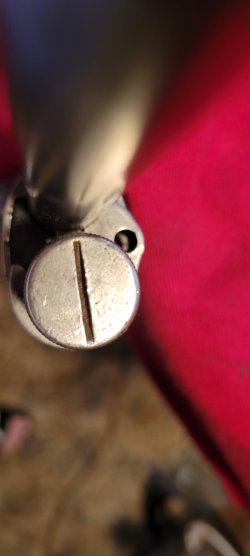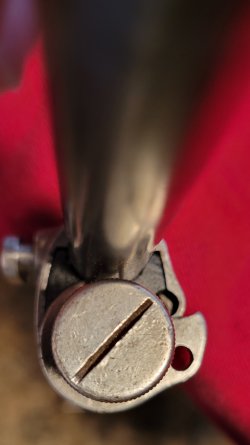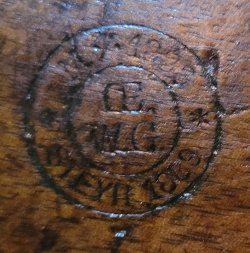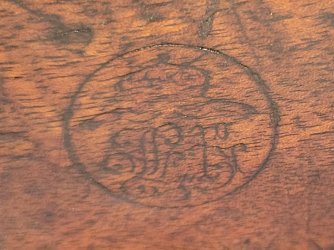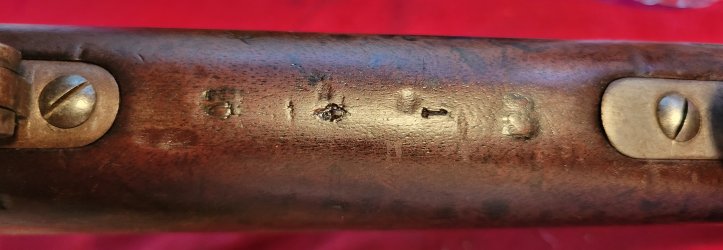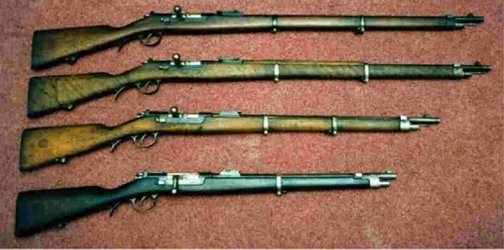This is my 2nd write-up in this series illustrating my milsurp collection. I know I had mentioned that I was going to write up the Krag next but I lied! Seriously I did say I was going to go chronologically and I realized this should have gone first. The trapdoor is a model 1888 and this is an 1886 but essentially the Trap is an updated model 1884 it's design beats out the Krop by 2 years so here goes.
Model 1886 Portuguese Kropatschek short rifle made in 1889. This is the extremely rare "short rifle" with no documented specific issue. It has been referred to as the "artillery rifle" but is also known as the "NCO's or Officers rifle". The truth has been lost to the anals of history. These rifles were built to an extremely high standard of fit and finish by Steyr of Austria. They are essentially a Mauser Model 71/84 chambered in the 8mm Guedes (8x60R) which was their standard rimmed cartridge carried over from the short lived Model 1885 Guedes single shot rifle, which was similar to the British Martini-Henry. The contract for the 1885 Guedes was quickly canceled with Steyr in favor of the 1886 of Kropatschek.

M1885 8mm Guedes Rifle
Technically cutting edge at the time it was manufactured the Kropatschek is a somewhat weak action with no actual locking lugs and only the bolt root for safety. It has a 2 piece bolt and an extremely long bolt throw due to the tube magazine feeding gate. Equipped with a side mounted cleaning rod the bayonet was also mounted to the side due to the weakness of the lower tube magazine. This short and the long rifle use straight bolt handles while the cavalry carbine has a turned down one. Utilizing a tube magazine and perhaps the very first use of aluminum in a firearm, however in the wrong place. The spring under the feed gate that raises the round to be chambered is made of aluminum and is constantly prone to failure as it is a non springy material. The majority of these rifles today only function as a single shot due to that parts failure, fortunately mine is intact. If you encounter one with a steel spring it has been arsenal replaced during the rifles service life.
These rifles had a long career being fielded by Portuguese troops into 1904 by which time they were replaced by their own designed Vergueiro-Mauser. However many remained in service with the Portuguese and their colonies and many made their way to the front in WWI where they proved to be woefully inadequate. Loading through the open bolt into the tube magazine was a weak point in modern warfare. They were predominantly used in Africa by Portuguese colonial troops against the Germans who were fielding stripper clip fed GEWEHR 98's. The Kropatschek rifles saw their last combat when they were pulled out of arsenals to repel the Japanese during WWII in the Portuguese colony of Timor February of 1942. Although declared neutral in the war Portugal felt it necessary to protect their colonies when they were attacked. They failed to repluse the Japanese attacks and Timor was occupied until the end of the war. Subsequently a guerilla war was waged resulting in the deaths of 1,000 Japanese which caused the estimated deaths of 40-60,000 Timorese civilians through Japanese retribution.
I shot this rifle in the late 70's and early 80's using ammunition made in Chile between 1904 and 1919. Not the most accurate rifle I have ever used but I blame it on very old ammo which hang fired at times and a muzzle crown that isn't the best I've ever seen. A nice bright barrel with good strong rifling but weak at the crown.
Mechanically it operates very well with an extremely smooth action in single shot mode. When feeding from the magazine there is a distinct hick in the bolt pull when activating the feed gate, it's not terrible it's just there. Bolt removal is facilitated by loosening the large screw and raising the washer seen on the bolt. Easy enough to do which makes me wonder why the muzzle crown would be damaged. I can only blame generations of bubbas and fudds who had this rifle before me. The magazine and front band are removed by taking out the cleaning rod which holds a flat pin in place. That pin retains the magazine cap and front band. The magazine cap is then turned to the side and the magazine is pulled out. The other bands are conventional with screws to loosen at the bottom. There are 2 screws through the trigger guard that retain the receiver in the stock. This action is unusual in that it is cock on opening a full 12 years before the Mauser Model 98 is to come out. It has a somewhat heavy at almost 7 pounds two stage trigger and that can't be helpful for accuracy either. Perhaps if I shot it today being much more refined in my abilities I would do better with it but the fact that the ammo I have is 40 years older than it was then can't make things any better. I've included photos of the ammunition which utilizes a cupro-nickel jacketed bullet and is smokeless powder loaded very early-on after it was invented in the 1880's.
Enjoy and best regards, Bill
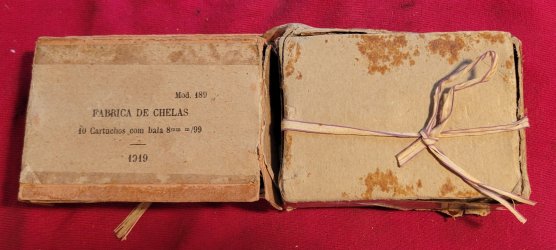
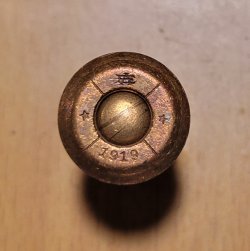
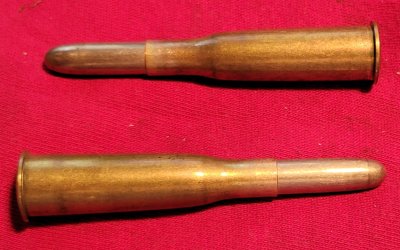


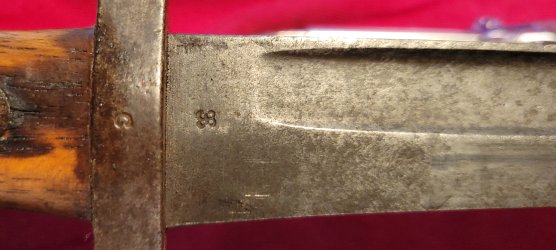
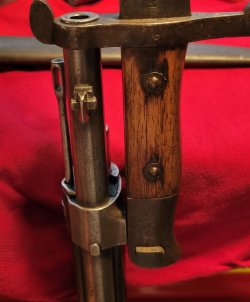
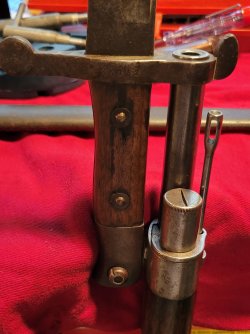
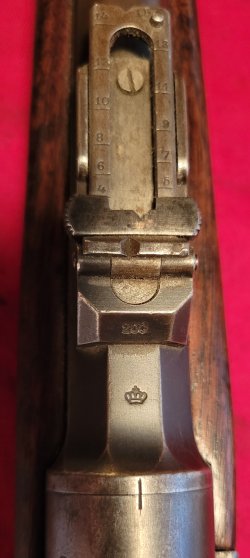
Model 1886 Portuguese Kropatschek short rifle made in 1889. This is the extremely rare "short rifle" with no documented specific issue. It has been referred to as the "artillery rifle" but is also known as the "NCO's or Officers rifle". The truth has been lost to the anals of history. These rifles were built to an extremely high standard of fit and finish by Steyr of Austria. They are essentially a Mauser Model 71/84 chambered in the 8mm Guedes (8x60R) which was their standard rimmed cartridge carried over from the short lived Model 1885 Guedes single shot rifle, which was similar to the British Martini-Henry. The contract for the 1885 Guedes was quickly canceled with Steyr in favor of the 1886 of Kropatschek.

M1885 8mm Guedes Rifle
Technically cutting edge at the time it was manufactured the Kropatschek is a somewhat weak action with no actual locking lugs and only the bolt root for safety. It has a 2 piece bolt and an extremely long bolt throw due to the tube magazine feeding gate. Equipped with a side mounted cleaning rod the bayonet was also mounted to the side due to the weakness of the lower tube magazine. This short and the long rifle use straight bolt handles while the cavalry carbine has a turned down one. Utilizing a tube magazine and perhaps the very first use of aluminum in a firearm, however in the wrong place. The spring under the feed gate that raises the round to be chambered is made of aluminum and is constantly prone to failure as it is a non springy material. The majority of these rifles today only function as a single shot due to that parts failure, fortunately mine is intact. If you encounter one with a steel spring it has been arsenal replaced during the rifles service life.
These rifles had a long career being fielded by Portuguese troops into 1904 by which time they were replaced by their own designed Vergueiro-Mauser. However many remained in service with the Portuguese and their colonies and many made their way to the front in WWI where they proved to be woefully inadequate. Loading through the open bolt into the tube magazine was a weak point in modern warfare. They were predominantly used in Africa by Portuguese colonial troops against the Germans who were fielding stripper clip fed GEWEHR 98's. The Kropatschek rifles saw their last combat when they were pulled out of arsenals to repel the Japanese during WWII in the Portuguese colony of Timor February of 1942. Although declared neutral in the war Portugal felt it necessary to protect their colonies when they were attacked. They failed to repluse the Japanese attacks and Timor was occupied until the end of the war. Subsequently a guerilla war was waged resulting in the deaths of 1,000 Japanese which caused the estimated deaths of 40-60,000 Timorese civilians through Japanese retribution.
I shot this rifle in the late 70's and early 80's using ammunition made in Chile between 1904 and 1919. Not the most accurate rifle I have ever used but I blame it on very old ammo which hang fired at times and a muzzle crown that isn't the best I've ever seen. A nice bright barrel with good strong rifling but weak at the crown.
Mechanically it operates very well with an extremely smooth action in single shot mode. When feeding from the magazine there is a distinct hick in the bolt pull when activating the feed gate, it's not terrible it's just there. Bolt removal is facilitated by loosening the large screw and raising the washer seen on the bolt. Easy enough to do which makes me wonder why the muzzle crown would be damaged. I can only blame generations of bubbas and fudds who had this rifle before me. The magazine and front band are removed by taking out the cleaning rod which holds a flat pin in place. That pin retains the magazine cap and front band. The magazine cap is then turned to the side and the magazine is pulled out. The other bands are conventional with screws to loosen at the bottom. There are 2 screws through the trigger guard that retain the receiver in the stock. This action is unusual in that it is cock on opening a full 12 years before the Mauser Model 98 is to come out. It has a somewhat heavy at almost 7 pounds two stage trigger and that can't be helpful for accuracy either. Perhaps if I shot it today being much more refined in my abilities I would do better with it but the fact that the ammo I have is 40 years older than it was then can't make things any better. I've included photos of the ammunition which utilizes a cupro-nickel jacketed bullet and is smokeless powder loaded very early-on after it was invented in the 1880's.
Enjoy and best regards, Bill










